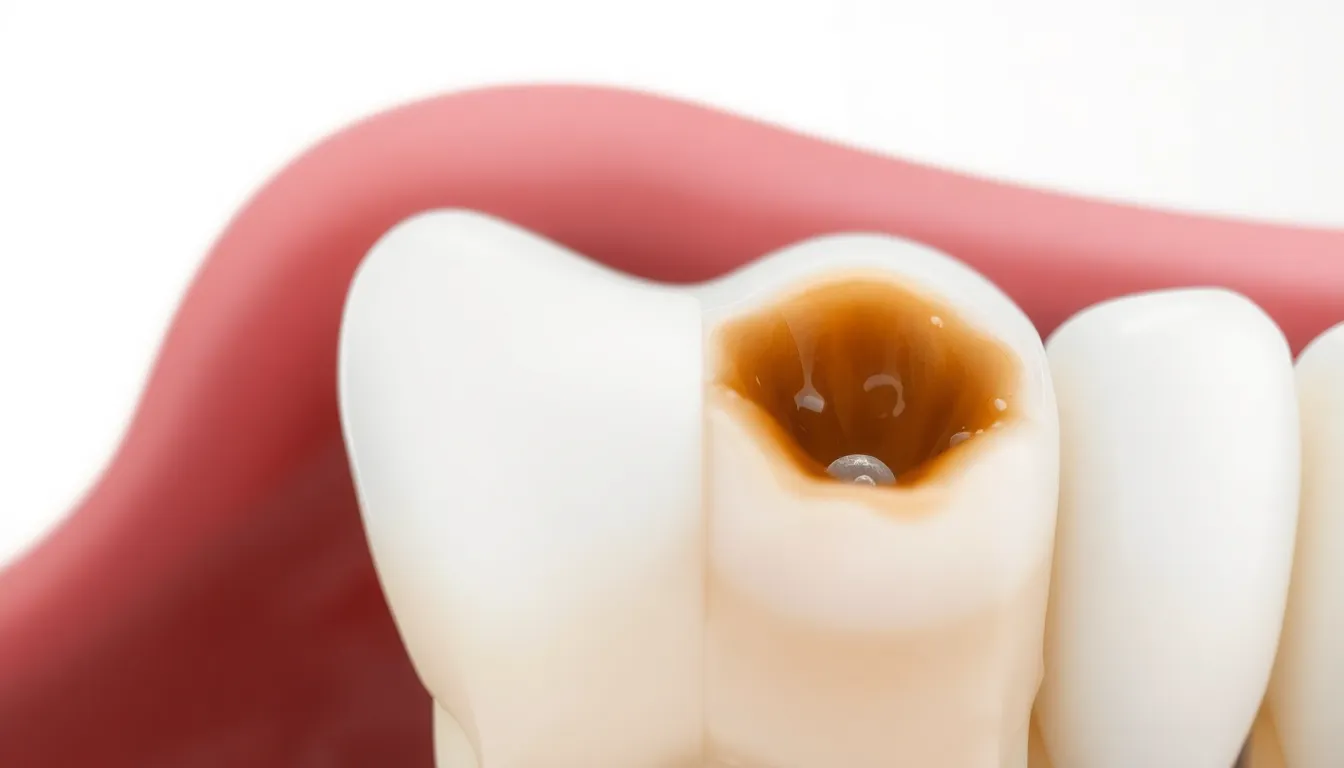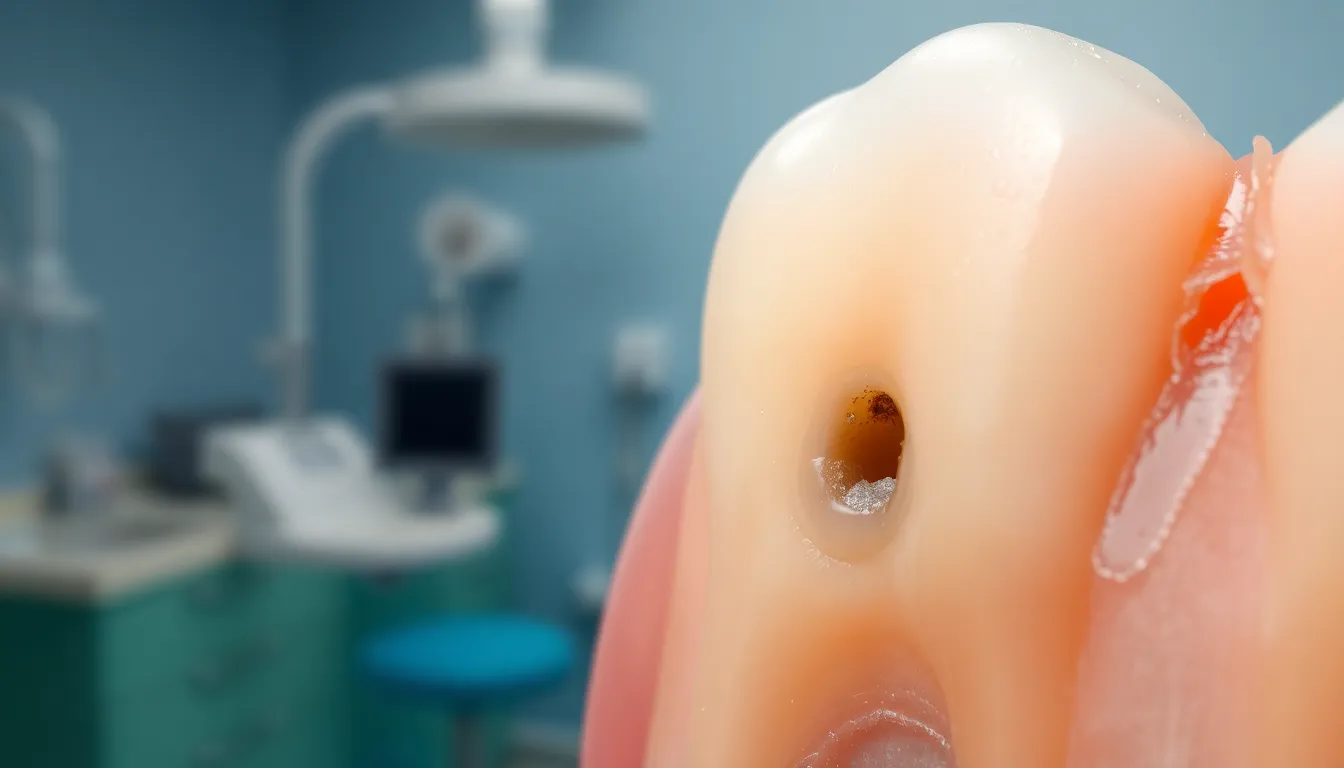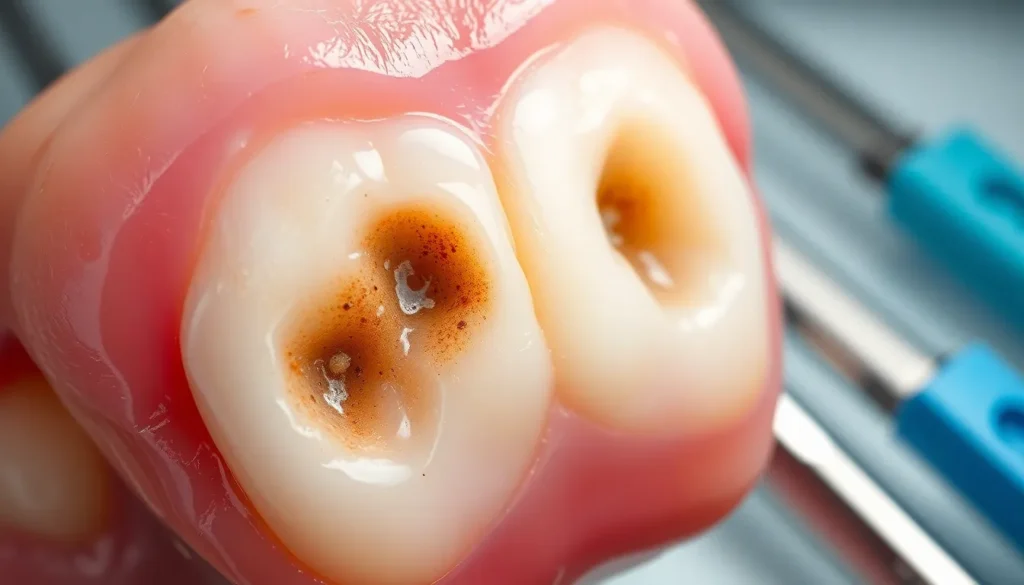Wondering what a small cavity looks like? That tiny dental imperfection might be causing you more harm than you realize, and catching it early could save you from painful dental procedures down the road.
When it comes to dental health, identifying small cavities is crucial for preventing their progression. These early-stage dental caries often appear as white spots, tiny dark pits, or slight discoloration on your tooth enamel. They’re easy to miss during your regular brushing routine, which is why knowing exactly what to look for can make all the difference in maintaining your smile’s health and avoiding more serious dental issues.
Understanding Dental Cavities: The Basics
Dental cavities form when bacteria in your mouth produce acids that gradually eat away at tooth enamel. These tiny holes develop through a process called demineralization, where minerals like calcium and phosphate are lost from the tooth surface. Early-stage cavities often appear as white spots or slight discoloration before progressing to more visible damage.
What Causes Cavities?
Cavities result from three primary factors working together: bacteria, sugary or acidic foods, and poor oral hygiene. Bacteria naturally present in your mouth feed on carbohydrates and produce acid as a byproduct. This acid attacks tooth enamel for up to 20 minutes after eating, creating the perfect environment for cavity formation. Regular consumption of sugary drinks, sticky candies, and processed carbohydrates significantly increases your cavity risk.
Dr. Todd B. Harris often tells patients, “I remember treating a 28-year-old patient who was surprised to discover three small cavities during a routine checkup. She hadn’t experienced any pain but had recently increased her consumption of energy drinks and snack foods during long work hours. This case perfectly illustrates how lifestyle changes can quickly impact dental health, even in adults with previously excellent oral hygiene.”
The Progressive Stages of Cavity Development
Cavities don’t appear overnight but develop through distinct stages. The initial stage involves white spots on tooth surfaces, indicating demineralization without actual cavity formation. Left untreated, these spots progress to small holes in the enamel layer, creating what dentists classify as incipient lesions. As decay continues, it penetrates deeper into the dentin layer, causing increased sensitivity and potential pain. The final stages involve pulp infection, abscess formation, and possible tooth loss if intervention doesn’t occur.
Different tooth surfaces develop cavities at varying rates. Pits and fissures on chewing surfaces collect food particles easily, making them common sites for early cavity formation. The smooth surfaces between teeth remain difficult to clean with brushing alone, creating another vulnerable area where small cavities frequently develop.
What Does a Small Cavity Look Like?

Small cavities present distinct visual cues that vary based on their stage of development and location on your tooth. Identifying these early signs helps you take action before decay progresses to more serious dental problems.
Visual Signs on Different Tooth Surfaces
Cavities appear differently depending on which tooth surface they affect. On chewing surfaces of molars and premolars, they typically form in tiny pits or grooves that collect food particles and bacteria. These cavities manifest as small brownish or black spots nestled in the crevices, often feeling sticky when your dentist examines them with a probe. Between teeth, cavities develop in areas that your toothbrush can’t easily reach, appearing as grey, brown, or black spots that persist even though regular brushing. Near the gumline, decay often shows as whitish or brown discoloration where plaque tends to accumulate. Smooth surface cavities form on the flat visible portions of teeth, initially showing as chalky white spots before potentially darkening as the decay advances.
Color Changes and Early Warning Signs
The earliest sign of a cavity is demineralization, which appears as white or chalky spots on your tooth enamel. These spots indicate that acids from plaque bacteria are leaching minerals from your tooth, weakening its protective outer layer. As decay progresses, these spots typically darken to light brown, dark brown, or black, signaling active decay in the tooth structure. Small pits or depressions might form alongside these color changes, creating slight indentations in the enamel surface. Dental X-rays reveal cavities as dark shadows contrasting against the solid white appearance of healthy tooth structure, often detecting decay before it’s visible to the naked eye.
How Small Cavities Develop and Progress

Small cavities develop through a progressive process that starts with tooth enamel damage and can advance to deeper layers if left untreated. Understanding this progression helps you identify problems early when treatment is simpler and less invasive.
From Demineralization to Visible Cavity
Demineralization marks the initial stage of cavity formation when oral bacteria produce acids that begin dissolving minerals in your tooth enamel. This early damage appears as small, white, chalky or opaque spots on the enamel surface, indicating weakened areas though no actual hole has formed yet. At this stage, the condition is completely reversible with proper oral hygiene practices and fluoride treatment.
As acid attacks continue, the enamel breaks down further, transitioning into the second stage where a small cavity or hole forms. These minor cavities typically look like tiny dark spots or brown areas on your tooth surface that might be mistaken for simple stains. Though visible, these cavities remain localized to the enamel layer and can usually be treated effectively with a standard filling.
Without intervention, the decay progresses to the third stage, reaching the dentin layer underneath the enamel. Dentin is softer and more sensitive than enamel, making this stage more problematic. The cavity appears larger and darker at this point, often accompanied by sensitivity to hot, cold, or sweet foods and drinks. This more serious stage requires prompt dental treatment to prevent further damage to your tooth structure.
Detecting Small Cavities at Home vs. Professional Diagnosis

Recognizing small cavities early significantly increases your chances of preventing extensive dental work. Though professional dental exams remain the gold standard for cavity detection, you can monitor your oral health between appointments using several reliable techniques.
Self-Examination Techniques
Regular self-checks help identify potential cavity warning signs before they develop into larger problems. Examine your teeth in a well-lit bathroom mirror, looking carefully for white, brown, or black discolorations that weren’t there before. Run your tongue across tooth surfaces to feel for any unusual roughness, small pits, or tiny holes that might indicate enamel breakdown. Pay attention to new tooth sensitivity, especially when consuming hot, cold, sweet, or acidic foods and drinks, as this often signals early enamel erosion or developing cavities.
Dr. Todd B. Harris notes, “Many patients come in surprised that what they thought was just a stain turned out to be the beginning of a cavity. I recommend monthly self-checks using a flashlight and dental mirror to spot these early changes.”
When to See a Dentist
Professional dental evaluation becomes necessary at the first sign of potential cavity development. Schedule an appointment immediately if you notice persistent white, brown, or black spots on your teeth that don’t brush away. Seek dental care when experiencing new tooth sensitivity, particularly sharp pain triggered by temperature extremes. Contact your dentist if your tongue detects any rough spots, pits, or holes on tooth surfaces. Mild or recurring toothaches, even if they come and go, warrant professional attention as they often indicate advancing decay.
Treatment Options for Small Cavities

Early intervention for small cavities can prevent more extensive damage and preserve your natural tooth structure. Modern dentistry offers several minimally invasive approaches that target decay in its earliest stages while maintaining as much healthy tooth material as possible.
Minimally Invasive Treatments
Dentists now focus on conservative treatment options that address small cavities without excessive drilling. Fluoride treatments represent one of the most effective early interventions, particularly for white spot lesions showing enamel demineralization. Professional-strength fluoride varnishes or gels help remineralize weakened areas, potentially reversing the earliest stages of decay without any drilling.
Dental sealants provide excellent protection for vulnerable chewing surfaces of molars and premolars. These thin plastic coatings seal off the deep pits and grooves where small cavities commonly begin, creating a smooth surface that’s easier to clean and resistant to bacterial invasion.
Resin infiltration offers a revolutionary approach for treating early cavities between teeth. This technique involves applying a special resin that penetrates into the demineralized area, strengthening the weakened enamel and halting decay progression without removing tooth structure.
Small composite fillings become necessary when decay has created a definite hole in the tooth. Unlike traditional amalgam fillings, today’s tooth-colored composite resins require minimal tooth preparation and bond directly to your natural tooth structure, creating a durable, natural-looking restoration.
Preventing Small Cavities from Getting Worse

Small cavities can be managed and potentially reversed with proper care when caught early. Taking proactive steps in your daily routine and making smart dietary choices significantly impacts the progression of early tooth decay.
Daily Oral Hygiene Practices
Brushing your teeth at least twice daily with fluoride toothpaste helps remineralize weakened enamel and prevents small cavities from expanding. Fluoride works by strengthening tooth structure and reversing early demineralization that appears as white spots. Flossing once daily removes plaque and food particles from between teeth—areas where cavities often begin and toothbrushes can’t reach effectively. Adding a fluoride mouthwash to your routine provides additional protection by killing bacteria and delivering cavity-fighting minerals to all tooth surfaces.
Dr. Todd B. Harris often shares with patients, “I’ve seen many cases where consistent oral hygiene habits completely reversed early cavity formation. One patient with three small demineralized areas avoided fillings entirely by implementing a rigorous brushing and flossing routine with prescription-strength fluoride toothpaste for just six weeks.”
Dietary Considerations
Limiting sugary and acidic foods and beverages dramatically reduces your risk of cavity progression. Sugar feeds the bacteria that produce enamel-eroding acids, while acidic drinks directly damage tooth structure—even small cavities can rapidly expand when exposed to these substances. Choosing calcium and phosphorus-rich foods supports enamel remineralization, with dairy products, leafy greens, and nuts being excellent options. Drinking plenty of water, especially fluoridated water, helps wash away food particles and neutralizes harmful acids produced by bacteria.
A 35-year-old patient who discovered white spot lesions during a routine check-up made simple dietary changes, replacing energy drinks with water and reducing snacking frequency. These adjustments, combined with proper oral hygiene, completely reversed her early-stage cavities in just three months. Regular water consumption throughout the day proved particularly effective at maintaining a neutral pH in her mouth, preventing the acidic environment where cavities thrive.
Conclusion
Spotting small cavities early gives you the power to protect your smile before serious damage occurs. Those white spots chalky areas or tiny dark pits are your warning signs that shouldn’t be ignored.
With regular self-checks using proper lighting and attention to new sensitivity you can catch problems between professional visits. Remember that early-stage decay can often be reversed with fluoride treatments or minimally invasive procedures.
Your daily habits matter tremendously in this battle against tooth decay. Consistent brushing flossing and smart dietary choices can mean the difference between a simple fluoride treatment and a deep filling.
Don’t wait until pain develops to take action. Partner with your dentist and commit to prevention to keep your natural teeth healthy for years to come.
Frequently Asked Questions
What are the early signs of a cavity?
Early cavity signs include white spots or chalky areas on teeth (demineralization), tiny dark pits, slight discoloration, and new sensitivity to temperature or sweetness. These subtle changes indicate enamel weakening before a visible hole forms. Regular self-examination with good lighting can help catch these early warning signs when treatment is simpler and potentially reversible.
How do cavities form in teeth?
Cavities form when bacteria in your mouth convert sugars into acids that gradually erode tooth enamel through demineralization. This process is influenced by three main factors: bacteria presence, consumption of sugary or acidic foods, and inadequate oral hygiene. Over time, the acid attacks create small holes that can penetrate deeper into the tooth structure if left untreated.
Which areas of teeth are most vulnerable to cavities?
The most vulnerable areas are pits and fissures on chewing surfaces of molars and premolars, where food particles easily get trapped. The smooth surfaces between teeth (interproximal areas) are also high-risk because they’re difficult to clean effectively with brushing alone. Additionally, areas along the gumline can be susceptible, especially if gum recession has exposed the tooth root.
Can small cavities be reversed without drilling?
Yes, early-stage cavities limited to enamel demineralization (white spots) can often be reversed without drilling. Treatments include professional fluoride applications, daily use of prescription-strength fluoride toothpaste, and improved oral hygiene practices. Resin infiltration is another minimally invasive option that strengthens weakened enamel. However, once a definite hole forms, some form of restoration is necessary.
How often should I check my teeth for cavities at home?
Dental professionals recommend performing a self-examination once a month. Use a flashlight and dental mirror to inspect all tooth surfaces for discoloration, roughness, or sensitivity. This regular monitoring helps identify potential issues between professional dental check-ups, which should occur every six months. Catching problems early allows for simpler, less invasive treatments.
What role does diet play in cavity development?
Diet significantly impacts cavity development. Frequent consumption of sugary foods and beverages provides fuel for acid-producing bacteria. Acidic foods and drinks (like energy drinks, sodas, and citrus) directly erode enamel. Snacking throughout the day, rather than eating at designated meal times, creates a continuously acidic environment in your mouth that accelerates tooth decay.
How are small cavities treated by dentists?
Treatment depends on the cavity’s stage. For early demineralization, fluoride treatments or dental sealants may be sufficient. Small cavities requiring restoration typically receive composite (tooth-colored) fillings, which are minimally invasive and preserve more natural tooth structure. Modern dentistry emphasizes conservative approaches that maintain as much healthy tooth material as possible while effectively halting decay progression.
Can flossing help prevent cavities between teeth?
Absolutely. Flossing is crucial for preventing cavities between teeth where toothbrush bristles cannot reach. These interproximal spaces are highly susceptible to decay because food particles and bacteria accumulate there easily. Daily flossing removes this buildup before it can cause damage. Studies show that combining proper brushing with regular flossing significantly reduces cavity formation between teeth.
How do dental X-rays help detect small cavities?
Dental X-rays reveal cavities that aren’t visible during a visual examination, particularly those between teeth or beneath existing fillings. On X-rays, cavities appear as dark shadows against the lighter, healthy tooth structure. This technology can detect decay in its earliest stages before symptoms develop, allowing for more conservative treatment options and preventing extensive damage that would require more invasive procedures.
What happens if small cavities are left untreated?
Untreated small cavities inevitably progress into larger ones. The decay continues through the enamel into the dentin, potentially reaching the pulp where nerves and blood vessels reside. This progression causes increasing sensitivity, pain, infection, and eventually tooth loss. What might have been treated with a simple filling could require root canal therapy or extraction, demonstrating why early intervention is essential.







